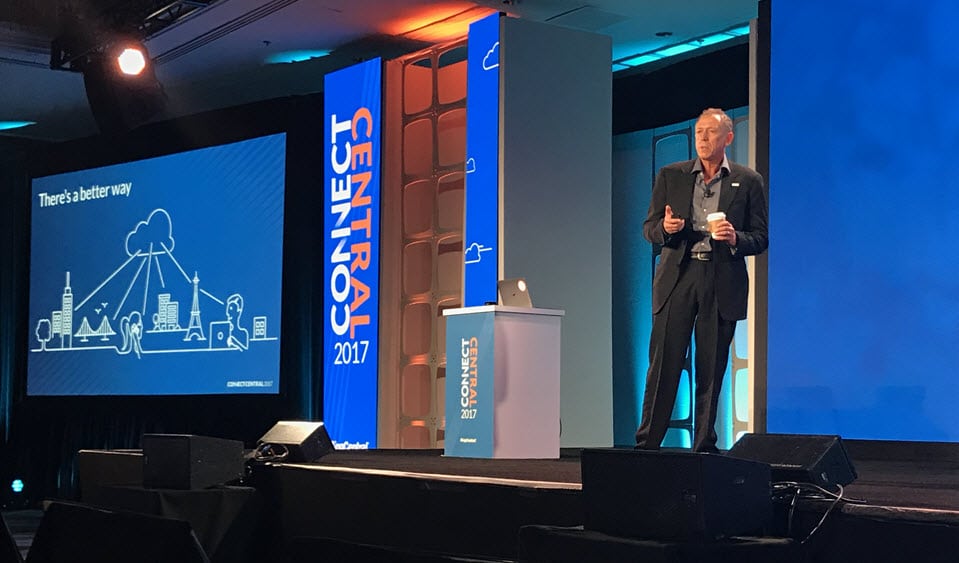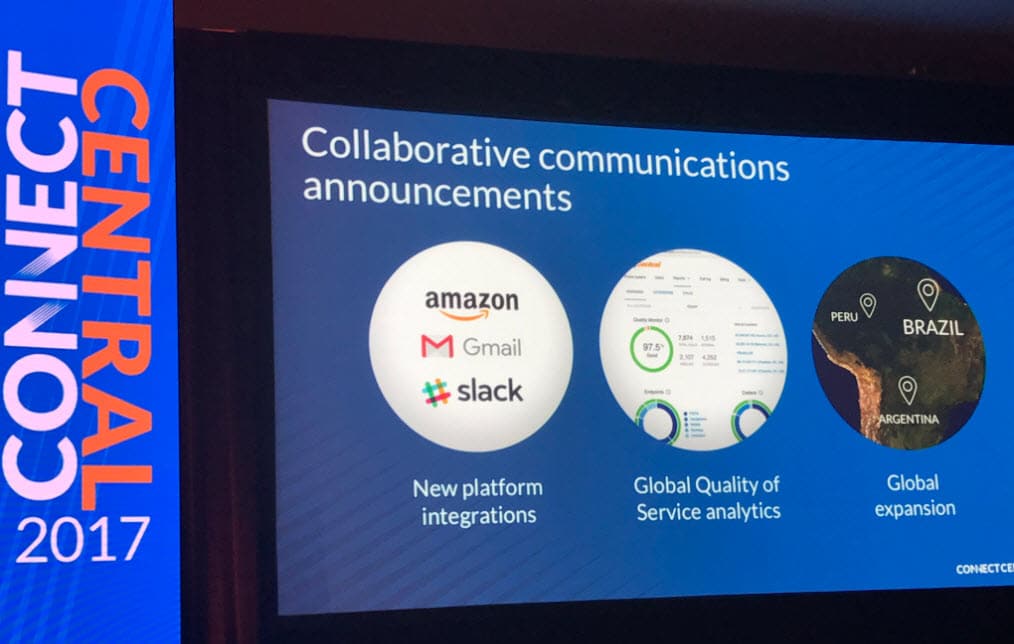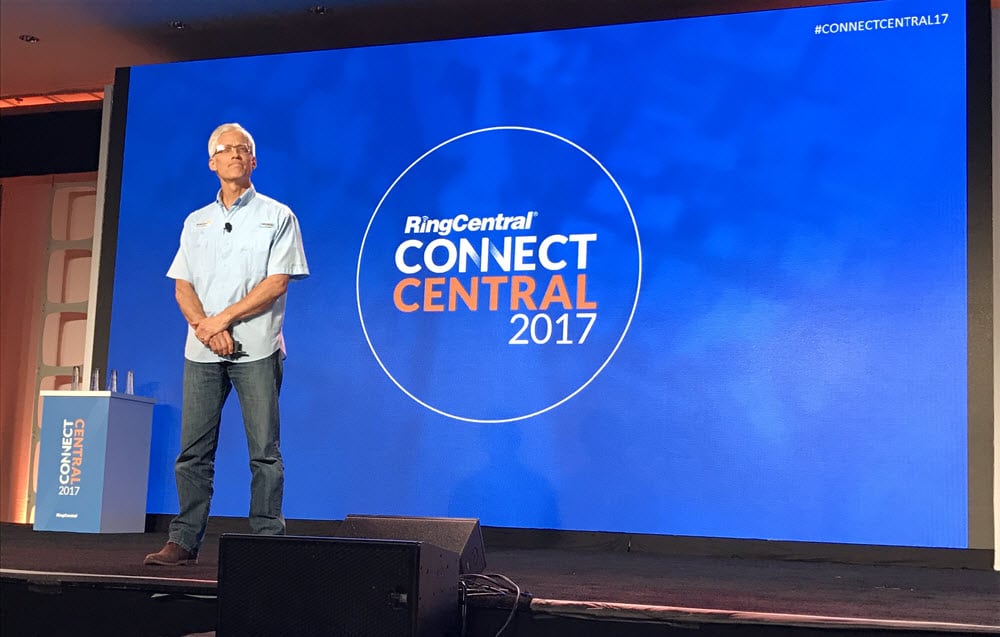For years, a big part of the RingCentral story has been moving business communications to the cloud and in particular about eliminating the need for traditional office phone system hardware. In his opening keynote at the RingCentral ConnectCentral 2017, CEO, Founder, and Chairman of the Board Vlad Shmunis was ready to declare victory on that score — and explain how RingCentral is moving on to bigger ambitions.
“We are not just about replacing PBX-es,” he said, referring to the private branch exchange boxes steadily disappearing from wiring closets across the world. “We’re about collaborative communications.” That’s a broader vision about using communications technologies purposefully to enable workplace collaboration of all sorts, where people and the ways they work together rather than technology are at the center of the equation.
By embracing a broader suite of communications and collaboration capabilities, RingCentral customers not only make their organizations more productive but also save substantial money by eliminating redundant applications, for example by replacing their subscriptions to other online meeting services with RingCentral Meetings, a powerful video conferencing and screen sharing tool included with RingCentral Office. In the same way, they can replace a standalone team messaging product like Slack with Glip. Combined, these tools allow the employees of an organization to move smoothly from team messaging, to calling, to video meetings. They can have instant access to everyone in the company, by whatever means of communication makes the most sense for the job at hand through an interactive directory that is always up to date.
That leaves legacy technology providers who have yet to completely transition away from older models of shipping hardware and developing software in the dust, Shmunis said, getting a laugh with his quip (attributed to a customer) that “you guys can deploy in the time it takes Avaya to quote.”
The rest of the day might be summed up as a series of proof points communications and collaboration in the cloud makes a big difference, with the evidence coming even more from the customers speaking at the show than from any RingCentral executive.
Here are just a few of the great stories told throughout the day.
Constructing a Resilient Organization
Jason Kasch, CIO at the engineering and construction firm Structural Group, spoke about the goal of allowing “any employee to connect with anyone else in the company with whatever medium they’re most comfortable with, whether that’s a phone call a video conference, a document share, or a Glip team.”
With the RingCentral apps for smart phones, construction workers — even those high up on the scaffolding at a construction site — can be in instant contact with an engineer on the ground in a construction trailer or in a remote headquarters office to resolve a problem when conditions in the field don’t match the engineering drawings. Glip and RingCentral Meetings make it easy to share visual information, so the engineers can see exactly what the problem is. If the drawings need to be changed, those changes can be shared electronically — and problems that used to take days to resolve can be solved in minutes.
With his communications infrastructure in the cloud, Kasch also knows he is protected against disasters such as fires and floods because his core technology is offsite and backed up at multiple RingCentral data centers. “Our facility might be under water, and our financial system might not be running, but if a customer calls, that call is going to go through,” he says.
Mobile, Global Reach
RingCentral’s international product, Global Office, is now in 37 countries, with Brazil just announced as the latest addition and Peru and Argentina coming soon. That means RingCentral offers complete local phone service in those countries, in addition to unified management of the communications and collaboration network for global organizations. While it takes time to navigate the maze of local regulations in regions like Latin America, the entry into Brazil shows that RingCentral will persist in making it happen in response to customer demand, said Ritu Mukherjee, VP of Product Management for global services.
One customer who very much appreciates the effort is Lee Goldenberg, CIO at the fashion clothing company John Varvatos. When the firm was spun off from its former corporate parent VF Corp. in 2012, Goldenberg was brought in to replace “every single system the company had.” That included an old Nortel PBX that as sitting in the office.
With a lean IT staff of five people, including Goldenberg himself, the decision to move entirely to cloud systems was an easy one. In terms of communications service, it also proved economical. “We saved 40% to 50% on communications costs — and those are hard numbers, not projections, invoice to invoice,” he says. In addition to replacing the PBX, he was able to phase out another video conferencing service in favor of RingCentral Meetings.
But the biggest benefits came from international reach. Even before the official launch of Global Office, RingCentral was able to give him calling from New York to Milan as if it was a local number. And on a business trip to Hong Kong, his CEO “fell in love with the mobile app,” Varvatos says. “He’s in Hong Kong, he presses the icon with my name, and my phone rings — perfect clarity, instant connection.”
International reach is critical for a company with global supply chain logistics, he says. And even as something as simple as having an always up to date corporate directory available via the RingCentral apps eliminates a cumbersome corporate process of someone manually updating a directory to be share in Excel, which is always a little out of date. “Now, as soon as we make the entry in Active Directory, we’re good, we’re done — for the whole world to see right then and there.”
Excelling at “the People Business”
One of the ways RingCentral is evolving from calling to collaboration is with its emphasis on Glip, its team messaging platform, as a way of linking together all other forms of communications.
“Sometimes messaging is the best way, sometimes calling is a little better, and sometimes you really need face-to-face,” explained Jason Copeland, VP of Product Management for Collaboration. With Glip as part of RingCentral Office, employees can move smoothly between all those modes. The collaboration product itself also extends beyond messaging to functions like task management and a document preview capability that allows precise annotations of a specific part of a document or image. Both are things you don’t get with Slack, a key competitor in team messaging.
Gabriel Rapisardo, Chief Revenue Officer at Hawk Ridge Systems, said RingCentral’s strategy of focusing on collaboration was a perfect match for his organization’s needs. The company is a value added reseller of 3D modeling software like Solidworks as well as 3D printers. On a deeper level, however, Rapisardo said, “We’re in the people business — nobody has figured out how to run a business without people.”
Operating across 17 offices and experiencing rapid growth, Hawk Ridge decided it needed to change the way it was managing and supporting its people. Rapisardo also wanted to do a better job of retaining his best sales people, including younger staff members. While Millennials are often maligned, he says he has concluded they are just the latest generation to have figured out that the way those senior to them have always done business may not be the best way. And while they shy away from traditional collaboration tools like email, it’s not because they don’t want to collaborate — they want to collaborate more continuously, with better mechanisms for making course corrections before heading down a dead end path.
Given access to a modern messaging environment, “now they’re collaborating to go after complex deals, whereas before they were all in their own cubicles,” he says, while frequent video meetings mean “I’m seeing much more of them now than I ever did before.”
Most importantly, staff attrition is down to about 6%, compared to an industry average of more like 15%, Rapisardo said. “In fact, some people would say if it’s under 15%, you should probably fire some folks. I disagree. I like my people.”
Stretching Dollars for a Global Mission
The closing keynote of the day, from World Vision USA CIO William L. Randolph was not only a story of return on investment from the cloud but an inspirational story about redirecting those savings to a humanitarian mission.
World Vision is a Christian charity dedicated to combatting the systemic causes of poverty and suffering around the world. One of is major initiatives has been helping with access to clean water, and the organization is currently active in helping with hurricane recovery in Puerto Rico as well as in the third world. World Vision also funds local healthcare workers and many other services.
Randolph told the story of visiting one of the water projects at a remote village in India and encountering a young girl who was suffering from a life threatening heart condition for the lack of a surgery seen by his own organization’s workers as hopelessly expensive — meaning it might cost as much as $2,000. At the time, he had been routinely making “$100,000 decisions” in the course of an upgrade to the organization’s Oracle ERP system. When he returned to his IT work, it was with a new focus on finding better ways of stretching the organization’s dollars so more of them could go to its mission.
Meanwhile, one of the IT upgrade needs he had been ignoring was an old PBX system that was already “starting to get cranky” when he arrived on the job in 2006. Ten years later, he knew he was skating on thin ice when his staff had to search for replacement parts on eBay. He didn’t want to spend money on a replacement PBX, but he authorized his staff to look at “creative options.”
What won him over about RingCentral “wasn’t all the bells and whistles, of which there are many” but the basic quality of the service, he said. Although World Vision had to buy new telephone handsets that would work with RingCentral, they quickly paid for themselves, and the direct savings from the new phone system wound up being about $150,000 per year.
What turned out to be much more significant was the opportunity to rethink how World Vision did business, now that its communications system was no longer anchored to hardware or to specific locations. Some of the organization’s business as usual practices included putting a phone on every desk, even for traveling employees who were rarely at their desk. Now many of those phones went away, and so did many of the desks. Dedicated video conferencing equipment and services were replaced by RingCentral Meetings. The practice of having traveling executives buy local SIM cards for their phones whenever they visited a new country could be done away with, given that the RingCentral app allowed them to use the same phone number anywhere in the world. Allowing people to do more with their phones meant the budget for PCs and tablets could be cut.
In all, the business processes enabled by moving to the cloud added up to about $2 million, Randolph said. This became part of a broader business initiative to squeeze efficiencies out of IT, which resulted in a savings of about $6 million that can now be directed toward World Vision’s humanitarian work.
Meanwhile, the requirement for tighter collaboration among aid workers in the field gets greater with every new crisis, Randolph said. While he is not sure what the ideal system of the future will look like, “What I do believe is those tech leaders who think they are supporting collaboration by just providing voice and email are the ones who are going to get left behind.”
Originally published Oct 25, 2017, updated Sep 29, 2020






